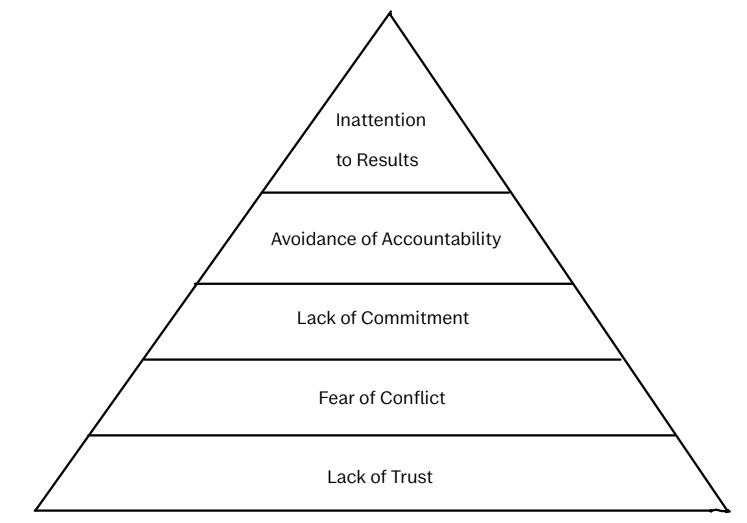Dysfunctional Teams tend to be dysfunctional in the same 5 ways
Teams of all levels, whether on the front lines with a team of individual contributors, or a team of executives working together to run a business, suffer from common dysfunctions. In 2002, Patrick Lencioni introduced the 5 Dysfunctions of a Team model in his book of the same name. These dysfunctions build upon each other, like a pyramid. We must resolve the dysfunctions at the lower levels before we tackle problems at a higher level. Just like in the construction of a building, the foundation is the most crucial piece. However, all levels are key to a well functioning team.
Lack of Trust
Trust is key to any relationship. When we bring many people together, each person has a relationship with everyone else in the group. While it may not be possible for everyone in the group to have high trust in eachother, a significant lack of trust will result in suspicion and a “trust tax” that the group will suffer from, slowing progress of the team.
Fear of Conflict
Some people naturally avoid conflict. They have a strong avoidance of it. In a team, healthy conflict, rooted in respect, is crucial to creativity and solving problems that the team will encounter. Most teams exist to solve problems and they will be hampered at their problem solving ability if they avoid conflict.
Lack of Commitment
A successful team needs everyone working together to achieve the goal of the team. If one or more team members aren’t committed to the goal, everyone suffers. The team may not operate at its full potential, other team members may have to work extra, or the uncommitted team members could be disruptive to the goal of the rest of the team.
Avoidance of Accountability
On a team, each person brings a unique set of skills and experiences. Together, the team can leverage their skills and expertise to achieve the team goal. Only, that is, if everyone is accountable to their part and the team. If team members avoid accountability, others will not be able to rely on them and their contributions.
Inattention to Results
Only in the final dysfunction do we consider the results of the team. So many other behaviors are necessary before we consider ‘are we successful?’
If we are inattentive to the results of our team, then we are missing an opportunity for feedback. We miss recognizing when we are failing to deliver, but we could also miss out celebrating our successes. This behavior could lead to burn out, which could be equally detrimental to the long term longevity of the team.
Bringing it together
One key use of the 5 dysfunctions model is in launching a team. One should start by establishing trust, and no, trust falls are not the answer.
Next, teams should work to establish how they will work together and handle disagreements. There will be disagreements and it is best to establish how to approach and resolve conflicts before one emerges.
Then, as we kickoff a new team, we consider what our purpose is, how we contribute, and ultimately build towards a commitment to the team’s success.
As we discuss how each person contributes to the team’s success, we should be explicit in what each person is accountable for. Spell out what each person can expect from each other and we know who is doing what.
Finally, a team launch that is anchored in the 5 dysfunctions will consider what success for the team looks like. Consider how will we measure our success? How often will we check in with these measures? How will we make these measures actionable?
While the 5 dysfunctions of a team is a useful model for new teams, it is tremendously helpful for existing teams to determine where the team struggles. If you sense your team is struggling in one or more areas in this model, try this exercise. First, introduce the model to the team and explain each level, drawing the pyramid as you go. Then, invite them to put a sticker or mark on the layer they think the team is currently struggling with the most. Next invite the team into a discussion around the results, asking for observations that confirm or challenge the results. Finally, consider how you’ll tackle this dysfunction as a team to get better.
